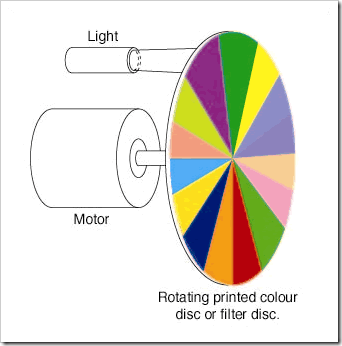-
Newton’s Colour Wheel – The Reality
Posted on October 26th, 2009 No commentsModern physics considers that Newton’s rotating disc experiment proves that White light is composed of a combination of colours. The original experiment consisted of a rotating disc painted with various coloured sectors. As the speed increases the colours blur and become a greyish colour. The argument that this proves that White light is composed of the different colours is totally untrue. Most paints and dyes include white pigments to obtain the lighter shades. As the disc rotates the reflected light is a mixture of Blue, Red, Yellow and White light

The predominant pigment seen is White and this is seen for most of each rotation of the wheel. If 10 of the 15 sectors contain White pigment then White light will be seen for 2/3rds of each revolution.
If there are Red pigments in 5 of the 15 sectors then Red light will be seen for 1/3rd of each revolution. Similarly for Blue and Yellow pigments.
Also of importance is the relative energy of the reflected light. The White light has considerably more energy than the other colours and will therefore have a greater affect than just its relative proportion. Yellow will have a greater affect than Red or Blue, etc..
If we use a filter disc and shine a White light through it, we have a similar situation. Most filters allow some white light through them. In general therefore we will see White light for 100% of each revolution of the wheel. The points in the previous paragraphs also then apply.
The actual shades and percentages of pigmentation will determine the shade of ‘Grey’ seen.
If we had 25% each of Blue, Red, Yellow and White pigments, then the reflective energy of the 25% White would probably be greater than the combined energies of the other colours.
Note that what if we look at a sheet of ‘White’ paper whilst inside a well lit room, it reflects only about 10% of the energy that it would if viewed outside on an overcast day. It still appears to be White in both locations.
The retinal cones are also confused by the constant colour changes above 16 changes per second. The relative constancy of the White during each revolution allows the cones to easily identify White.
Although normally used to ‘obtain’ varying shades of Gray, the colour wheel can be used to produce any colour by using only White, Yellow, Red, Dark Blue and Black sectors in varying proportions.
If the wheel only has Yellow and Blue pigment sectors or filters the colour seen is Green, therefore ‘proving’ that Green light is composed of Yellow and Blue light. If you only use Red and Green on the wheel you get Gray/Khaki, not Yellow as argued by the physicists. This is using the same principles/hypotheses as the physics establishment.
However, if you force (Yellow + Blue) = Green + Red into the same space the total energy (Speed) increases into the Yellow range or even sometimes into White. Basic Fluid mechanics.
Author.-Brian Williams
See An Introduction to Colour for further information.
See also Projected Light , Colour and the Prism andTechnorati Tags: Newton’s Colour Wheel

